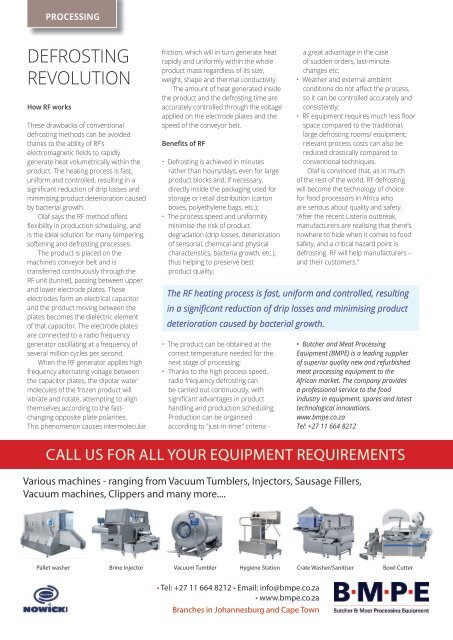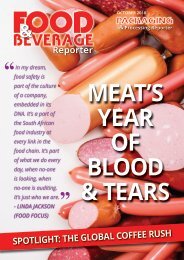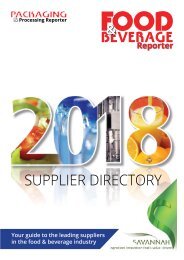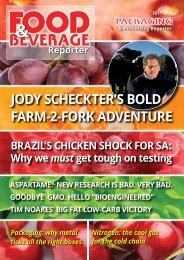Food & Beverage Reporter August 2018
South Africa's leading B2B magazine for the food & beverage sector and its allied industries in processing/packaging etc
South Africa's leading B2B magazine for the food & beverage sector and its allied industries in processing/packaging etc
You also want an ePaper? Increase the reach of your titles
YUMPU automatically turns print PDFs into web optimized ePapers that Google loves.
PROCESSING<br />
DEFROSTING<br />
REVOLUTION<br />
How RF works<br />
These drawbacks of conventional<br />
defrosting methods can be avoided<br />
thanks to the ability of RF’s<br />
electromagnetic fields to rapidly<br />
generate heat volumetrically within the<br />
product. The heating process is fast,<br />
uniform and controlled, resulting in a<br />
significant reduction of drip losses and<br />
minimising product deterioration caused<br />
by bacterial growth.<br />
Olaf says the RF method offers<br />
flexibility in production scheduling, and<br />
is the ideal solution for many tempering,<br />
softening and defrosting processes.<br />
The product is placed on the<br />
machine’s conveyor belt and is<br />
transferred continuously through the<br />
RF unit (tunnel), passing between upper<br />
and lower electrode plates. These<br />
electrodes form an electrical capacitor<br />
and the product moving between the<br />
plates becomes the dielectric element<br />
of that capacitor. The electrode plates<br />
are connected to a radio frequency<br />
generator oscillating at a frequency of<br />
several million cycles per second.<br />
When the RF generator applies high<br />
frequency alternating voltage between<br />
the capacitor plates, the dipolar water<br />
molecules of the frozen product will<br />
vibrate and rotate, attempting to align<br />
themselves according to the fastchanging<br />
opposite plate polarities.<br />
This phenomenon causes intermolecular<br />
friction, which will in turn generate heat<br />
rapidly and uniformly within the whole<br />
product mass regardless of its size,<br />
weight, shape and thermal conductivity.<br />
The amount of heat generated inside<br />
the product and the defrosting time are<br />
accurately controlled through the voltage<br />
applied on the electrode plates and the<br />
speed of the conveyor belt.<br />
Benefits of RF<br />
• Defrosting is achieved in minutes<br />
rather than hours/days, even for large<br />
product blocks and, if necessary,<br />
directly inside the packaging used for<br />
storage or retail distribution (carton<br />
boxes, polyethylene bags, etc.);<br />
• The process speed and uniformity<br />
minimise the risk of product<br />
degradation (drip losses, deterioration<br />
of sensorial, chemical and physical<br />
characteristics, bacteria growth, etc.),<br />
thus helping to preserve best<br />
product quality;<br />
• The product can be obtained at the<br />
correct temperature needed for the<br />
next stage of processing;<br />
• Thanks to the high process speed,<br />
radio frequency defrosting can<br />
be carried out continuously, with<br />
significant advantages in product<br />
handling and production scheduling.<br />
Production can be organised<br />
according to "just-in-time" criteria -<br />
a great advantage in the case<br />
of sudden orders, last-minute<br />
changes etc;<br />
• Weather and external ambient<br />
conditions do not affect the process,<br />
so it can be controlled accurately and<br />
consistently;<br />
• RF equipment requires much less floor<br />
space compared to the traditional,<br />
large defrosting rooms/ equipment;<br />
relevant process costs can also be<br />
reduced drastically compared to<br />
conventional techniques.<br />
Olaf is convinced that, as in much<br />
of the rest of the world, RF defrosting<br />
will become the technology of choice<br />
for food processors in Africa who<br />
are serious about quality and safety.<br />
“After the recent Listeria outbreak,<br />
manufacturers are realising that there’s<br />
nowhere to hide when it comes to food<br />
safety, and a critical hazard point is<br />
defrosting. RF will help manufacturers –<br />
and their customers.’’<br />
The RF heating process is fast, uniform and controlled, resulting<br />
in a significant reduction of drip losses and minimising product<br />
deterioration caused by bacterial growth.<br />
• Butcher and Meat Processing<br />
Equipment (BMPE) is a leading supplier<br />
of superior quality new and refurbished<br />
meat processing equipment to the<br />
African market. The company provides<br />
a professional service to the food<br />
industry in equipment, spares and latest<br />
technological innovations.<br />
www.bmpe.co.za<br />
Tel: +27 11 664 8212<br />
CALL US FOR ALL YOUR EQUIPMENT REQUIREMENTS<br />
Various machines - ranging from Vacuum Tumblers, Injectors, Sausage Fillers,<br />
Vacuum machines, Clippers and many more....<br />
Pallet washer Brine Injector Vacuum Tumbler Hygiene Station Crate Washer/Sanitiser Bowl Cutter<br />
• Tel: +27 11 664 8212 • Email: info@bmpe.co.za<br />
• www.bmpe.co.za<br />
Branches in Johannesburg and Cape Town







